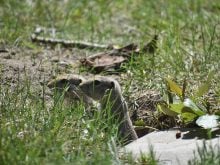Producers not already practising chemical fallow should consider it this year, or at least use chemicals to reduce the number of tillage operations, said Ken Panchuk, soil specialist with Saskatchewan Agriculture.
“Chem-fallow conserves moisture by preventing weeds and volunteer crops from depleting the moisture reserves,” he said.
Preserving residue cover prevents evaporation from the surface, keeps stubble anchored and prepares for direct seeding of next year’s crop.
Required light
Clark Brenzil, weed control specialist, said tillage can encourage weed growth since many weed seeds require light to germinate. Tilling the soil gives these weeds the flash of light they need to start growing.
Read Also

Agritechnica Day 2: The future of tractor power, building quicker crop apps and large farms and tech
Agritechnica Day 2: The future of tractor power, building quicker crop apps with Syngenta and large farms and tech
“Chem-fallow is also economical,” said Brenzil. “Cultivation as a weed control measure requires more operations to keep on top of the weeds. By contrast, once the annual weeds on the surface of the soil have germinated, they require one or maybe two spraying operations in the spring or early summer. Until the fall-germinating weeds start, just spot spraying for perennials is needed.
“The key to effective chem-fallow is to catch the weeds while they are still young. Spraying weeds when they are close to maturity not only makes the operation less effective but the damage has already been done.”
Grant McLean, extension agro-logist at Carnduff, agreed.
“Depending on conditions, the fuel and machinery costs are less for chem-fallow than for tillage. Given that you usually need to spray only twice at most, compared to the many tillage operations needed to control annuals, the chemical costs will not likely exceed the fuel savings.”
Brenzil says several options exist for chem fallow: glyphosate formulations such as Roundup, Touchdown, Glyphos, Wrangler and Laredo; a new non-selective product called Gramoxone PDQ, which is similar to a mix of Reglone and an old product called Sweep; and low-cost phenoxy alternatives such as 2,4-D and MCPA.














